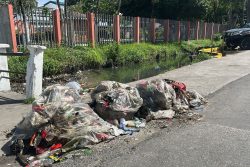By Janette Bulkan
In three earlier articles in this series on distortions in the rule of law in the forest sector in Guyana (Stabroek News, 12 and 30 January, and 06 February 2012), non-application or selective application of laws, policies and administrative procedures were shown to make it possible for timber log traders to maximize personal incomes by avoiding national policies for in-country processing and value addition. These practices mean non-compliance with the requirement in the National Constitution 1980/2003 that natural resources should be applied for the benefit of the nation rather than for personal profit. Avoiding the national policies also leaves the forest sector as an enclave economy for Asian factories, where skills are developed and used and employment is generated in Asia instead of in Guyana. Timber decking which is finished in the USA could be entirely produced in Guyana. Furniture and flooring made in China with Guyanese timber and exported to the European Union and North America could be entirely produced in Guyana. The Private Sector Commission’s argument that Guyana cannot compete in markets in developed countries because of tariff barriers is shown to be absurd by the success of the Chinese exporters in these markets with products based on Guyanese timbers. In addition, there are several arrangements for products from CARICOM countries to enter Northern markets with no or reduced trade barriers.
Suppose that the Guyana Forestry Commission and the Guyana Revenue Authority were to cease their discriminatory and selective practices and actually apply the laws and regulations and national policies as written. Suppose that the ‘policy directives’ of unknown authority, which set aside laws and regulations and which the GFC claims as justification for unconstitutional discrimination (recorded in the GFA Consulting Group report of December 2011), are properly abolished. Suppose that the Go-Invest investment incentives which supposedly apply to the forest sector actually do so without discrimination, and that VAT on domestic sales of timber logs is actually refunded within the promised 30 days instead of several months.
The GFC’s ‘quick reference guide for the implementation of the Code of practice for Wood Processing Facilities’ (undated, probably 2011) recommends that ‘investors/wood processors should . . . focus on niche markets that are lower volume but more dynamic in nature . . . low volumes and high values’. But then there are problems of lack of economy of scale, and the lack of co-operation between family-owned timber businesses in Guyana has been a persistent complaint from overseas timber buyers for almost 90 years. Memory of failures during the Burnham years taints the notion of co-operatives. In addition, almost two decades of consultancy reports comment on potential and actual negative effects of family ownership of businesses in the forest sector. Re-investment of profits into the core timber businesses as opposed to other investments is limited. Bookkeeping and accounting practices minimize tax exposure rather than make the business efficient. The obscurity of the family business accounts makes commercial banks wary of making loans. Nor are the Asian-owned companies which benefit from substantial FDI arrangements secretly negotiated with Cabinet any more reputable (‘Barama and the law’ by Chris Ram, Stabroek News, 02 June 2007). Suppose, however, that children of family enterprises who have business degrees from the University of Guyana or US universities were allowed to use their qualifications to develop the family businesses, and suppose that the commercial banks overcame their suspicion of the riskiness of timber businesses.
What can be done technically to bring the forest industry of Guyana closer to the efficiency and effectiveness of the parallel industries in China and India, so that we produce and export the finished products rather than the Asian factories use our timbers for exportable products?
It is a safe bet that it is not worth modernising the technically unsuitable second-hand gangsaws installed decades ago in several of the fixed sawmills of the older families. At least five factors are positive for a modernized forest industry:
1. Smaller logging concessions within a national strategic plan for forest allocation
The dynamic ecology of the natural tropical forest is better known (mainly through the doctorate studies of the programmes of the University of Utrecht and Tropenbos International from the 1980s to 2002). The natural infertility of the hinterland soils mean that Guyanese forests are never going to be as biologically productive or as commercially rich as those of the Amazon Basin or West Africa or South East Asia. So the harvesting and management models developed during FAO/FIDS in the late 1960s and early 1970s – large-scale logging concessions to amortize costs for extracting large quantities of huge logs – are not appropriate. Moreover, the long-lived trees are often defective and so yield low proportions of usable lumber. It therefore makes no sense to haul out logs with little prime lumber and a lot of residue. It makes more sense to leave the residues to decay back in the forest and to haul out only the usable lumber. This is what the chainsaw millers have been doing since the early 1990s, producing lumber at ¼ the cost of the fixed mills but at the cost of poorly sawn boards. Portable narrow-kerf high-strain bandmills now produce a much higher yield (up to 70 per cent log-to-lumber compared with 40 per cent in Guyanese fixed mills and less again with chainsaw milling) at 1/3 the cost of fixed mills. And the capital cost of portable bandmills is much less than for fixed mills. It is thus practicable to issue much smaller concession areas (relative to Barama’s 1.61 million ha) in the context of the national strategic plan for forest allocation, but still operating to sustainable forest management standards, to employ more people, to enhance local skills, and to provide a better return on investment.
2. Modern technology for processing Guyana’s timbers
More and more wood is consumed globally as engineered products. Wamara (botanical name Swartzia leiocalycina) and itikiboroballi (possibly two other of the 34 species of Swartzia in Guyana but more likely wamara under another name) were not popular in Guyana because the wood is difficult to saw with conventional steel blades. Asian metallurgists have developed saw blades which can saw this and similar timbers efficiently, so Asian log traders have been buying up under-appreciated timbers to convert into expensive high-end furniture and flooring, for consumption by the rising middle class in India or for export from China to Europe and North America. Merbau from South East Asia, cumaru (called ‘tonka bean’ in Guyana) and wamara/itikiboroballi are desired because of their timbers’ engineering properties, not because of their names. Wamara/itikiboroballi was little sold from Guyana before 2005 but during 2009 – September 2011 almost 70,000 m3 of logs were shipped to Asia, mostly for flooring. This timber was the second largest (after purpleheart) out of the total volume of 253,181 m3 of exported logs in this period. The third article in this series (Stabroek News, 06 February 2012 `The rule of law – what Guyana loses through export of timber logs to Asia’) showed how little we earned from this valuable timber compared with the Asian log traders and factories. In contrast, in Peru, a factory now has installed Chinese machinery to convert cumaru/tonka bean into almost-finished flooring, so capturing a much higher value for the producer country. We could do this in Guyana.
3. Marketing a technical product, not a timber name
The Guyana Forestry Commission (GFC) expressed surprise that dressed lumber of washiba (botanical name Tabebuia serratifolia, known as ipe in Brazil) was declared at FOB US$ 2500/m3. The fortnightly Timber Trade Marketing report from the International Tropical Timber Organization shows that Brazilian ipe decking (the end use for the Guyanese washiba) routinely imports into the USA at US$ 2650-2875. We could do that too, using several different species and selling according to the technical specifications for decking, not by timber name. In that way, the massive over-cutting which the GFC has allowed for purpleheart (by some 30 times its natural regeneration rate) and wamara would be avoided for other species.
4. Buying an engineering material
It is shameful that the GFC has abandoned the yield control by tree species which is prescribed in the GFC Code of Practice for Timber Harvesting (November 2002, section 2.3, page 8). However, instead, the GFC is pressing the holders of the large-scale Timber Sales Agreement concessions to work systematically through their approved logging blocks, extracting more species per hectare; this was first suggested in 1948 and is the norm in many other countries. The GFC allows up to 20 m3/ha over a 60-year rotation (forest regeneration period) but most loggers in Guyana take only 6-12 m3/ha, leaving much timber behind. The reason given by the loggers is that the other species are difficult to sell. That is because they are being sold as species, by timber name, instead of as an engineering material. The specifiers of government contracts could help by detailing requirements in terms of strength or durability characteristics, so that any timber which satisfies those requirements could be supplied, instead of only a small number of increasingly scarce timbers; scarce because those timbers have been over-cut for years past.
5. Selling and buying according to fitness for purpose
As part of its promotion of the Code of Practice for Wood Processing Facilities, the GFC should stimulate other government agencies and contractors, as well as consumers in general, to buy timber according to fitness for purpose. It makes no sense to buy top-grade purpleheart and then paint it white. Instead of detailing how sawmillers should do their sawing, the GFC should be teaching people to ask for timber by strength class or durability grade. In this way we could have more rational and more sustainable forest management and an abundant supply of cheaper timber.
Working on these five factors would be cheaper and easier than struggling to keep technically unsuitable and worn-out fixed sawmills in operation, or to build roads for trucks hauling massive logs. The GFC, the trade associations Forest Products Association and Guyana Manufacturers and Services Association, and the individual enterprises need to apply some strategic thinking before we exhaust our fine timbers through senseless conservative adherence to inappropriate traditional practices.









